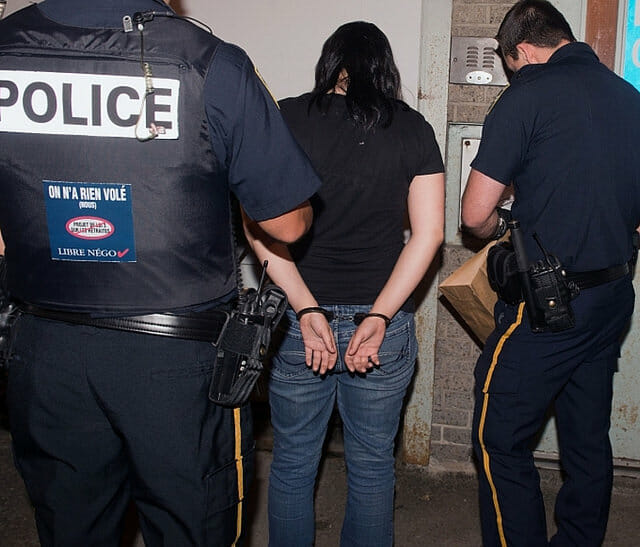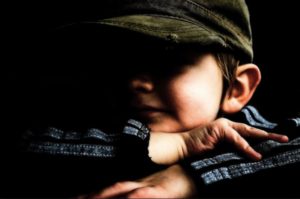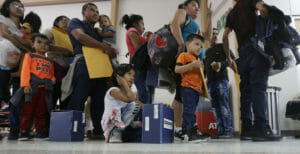Teens Kept at Virginia Center Say They Were Cuffed, Beaten
Immigrant children as young as 14 housed at a juvenile detention center—many were accused of belonging to violent gangs—claim they spent long periods in solitary confinement, nude and shivering. Girl in handcuffs. (picturexv / Flickr Creative Commons).
Girl in handcuffs. (picturexv / Flickr Creative Commons).
WASHINGTON — Immigrant children as young as 14 housed at a juvenile detention center in Virginia say they were beaten while handcuffed and locked up for long periods in solitary confinement, left nude and shivering in concrete cells.
The abuse claims against the Shenandoah Valley Juvenile Center near Staunton, Va., are detailed in federal court filings that include a half-dozen sworn statements from Latino teens jailed there for months or years. Multiple detainees say the guards stripped them of their clothes and strapped them to chairs with bags placed over their heads.
“Whenever they used to restrain me and put me in the chair, they would handcuff me,” said a Honduran immigrant who was sent to the facility when he was 15 years old. “Strapped me down all the way, from your feet all the way to your chest, you couldn’t really move. … They have total control over you. They also put a bag over your head. It has little holes; you can see through it. But you feel suffocated with the bag on.”
In addition to the children’s first-hand, translated accounts in court filings, a former child-development specialist who worked inside the facility independently told The Associated Press this week that she saw kids there with bruises and broken bones they blamed on guards. She spoke on condition of anonymity because she was not authorized to publicly discuss the children’s cases.
In court filings, lawyers for the detention facility have denied all the allegations of physical abuse detailed in the lawsuit, which span from 2015 to 2018.
Many of the children were sent there after U.S. immigration authorities accused them of belonging to violent gangs, including MS-13. President Donald Trump has repeatedly cited gang activity as justification for his crackdown on illegal immigration.
Trump said Wednesday that “our Border Patrol agents and our ICE agents have done one great job” cracking down on MS-13 gang members. “We’re throwing them out by the thousands,” he said.
But a top manager at the Shenandoah center said during a recent congressional hearing that the children did not appear to be gang members and were suffering from mental health issues resulting from trauma that happened in their home countries — problems the detention facility is ill-equipped to treat.
“The youth were being screened as gang-involved individuals. And then when they came into our care, and they were assessed by our clinical and case management staff … they weren’t necessarily identified as gang-involved individuals,” said Kelsey Wong, a program director at the facility. She testified April 26 before a Senate subcommittee reviewing the treatment of immigrant children apprehended by the Homeland Security Department.
Most children held in the Shenandoah facility who were the focus of the abuse lawsuit were caught crossing the border illegally alone. They were not the children who have been separated from their families under the Trump administration’s recent policy and are now in the government’s care. But the facility there operates under the same program run by the U.S. Office of Refugee Resettlement. It was not immediately clear whether any separated children have been sent to Shenandoah Valley since the Trump administration in April announced its “zero tolerance” policy toward immigrant families, after the lawsuit was filed.
It also was not immediately clear when federal authorities first learned of the abuse claims and whether any action was taken. Spokespeople for the federal Refugee Resettlement office, which is part of the Department of Health and Human Services, did not respond to multiple requests for comment Wednesday and Thursday.
Robert Carey, who served as director of Refugee Resettlement under the Obama administration, said Tuesday he only heard about the complaints at the Shenandoah center after he left office in January 2017. Had he known, Carey said, he “would have been all over that trying to figure out what needed to be done, including termination of contracts.”
The Shenandoah lockup is one of only three juvenile detention facilities in the United States with federal contracts to provide “secure placement” for children who had problems at less-restrictive housing. The Yolo County Juvenile Detention Facility in California has faced litigation over immigrant children mischaracterized as gang members. In Alexandria, Virginia, a multi-jurisdiction commission overseeing the Northern Virginia Juvenile Detention Center has said it will end its federal contract to house young immigration detainees when it expires in September.
The Shenandoah detention center was built by a coalition of seven nearby towns and counties to lock up local kids charged with serious crimes. Since 2007, about half the 58 beds are occupied by both male and female immigrants between the ages of 12 and 17 facing deportation proceedings or awaiting rulings on asylum claims. Though incarcerated in a facility similar to a prison, the children detained on administrative immigration charges have not yet been convicted of any crime.
Virginia ranks among the worst states in the nation for wait times in federal immigration courts, with an average of 806 days before a ruling. Nationally, only about half of juveniles facing deportation are represented by a lawyer, according to Justice Department data.
On average, 92 immigrant children each year cycle through Shenandoah, most of them from Mexico and Central America.
Wong said many of the 30 or so children housed there on any given day have mental health needs that would be better served in a residential treatment unit. But such facilities are often unwilling to accept children with significant behavioral issues, she said.
Wong and other managers at the Shenandoah center, including Executive Director Timothy J. Smith, did not respond to phone and email messages seeking comment this week.
Financial statements reviewed by AP shows the local government commission that operates the center received nearly $4.2 million in federal funds last year to house the immigrant children — enough to cover about two-thirds of the total operating expenses.
The lawsuit filed against Shenandoah alleges that young Latino immigrants held there “are subjected to unconstitutional conditions that shock the conscience, including violence by staff, abusive and excessive use of seclusion and restraints, and the denial of necessary mental health care.”
The complaint filed by the nonprofit Washington Lawyers’ Committee for Civil Rights and Urban Affairs recounts the story of an unnamed 17-year-old Mexican citizen apprehended at the southern border. The teen fled an abusive father and violence fueled by drug cartels to seek asylum in the United States in 2015.
After stops at facilities in Texas and New York, he was transferred to Shenandoah in April 2016 and diagnosed during an initial screening by a psychologist with three mental disorders, including depression. Besides weekly sessions speaking with a counselor, the lawsuit alleges the teen has received no further mental health treatment, such as medications that might help regulate his moods and behavior.
The lawsuit recounts multiple alleged violent incidents between Latino children and staff at the Shenandoah center. It describes the guards as mostly white, non-Spanish speakers who are undertrained in dealing with individuals with mental illness. The suit alleges staff members routinely taunt the Latino youths with racially charged epithets, including “wetback,” ″onion head” and “pendejo,” which roughly translates to dumbass in Spanish.
A 16-year-old who said he had lived in Texas with his mother since he was an infant ended up at Shenandoah in September after a police officer pulled over a car he was riding in and asked for ID, which he couldn’t provide. As one of the few Latino kids who is fluent in English, the teen would translate for other detainees the taunts and names the staff members were calling them. He said that angered the guards, resulting in his losing such modest privileges as attending art classes.
“If you are behaving bad, resisting the staff when they try to remove you from the program, they will take everything in your room away — your mattress, blanket, everything,” he said. “They will also take your clothes. Then they will leave you locked in there for a while. This has happened to me, and I know it has happened to other kids, too.”
The immigrant detainees said they were largely segregated from the mostly white juveniles being held on criminal charges, but they could see that the other housing units had amenities that included plush chairs and video gaming consoles not available in the Spartan pods housing the Latinos.
In their sworn statements, the teens reported spending the bulk of their days locked alone in their cells, with a few hours set aside for classroom instruction, recreation and meals. Some said they had never been allowed outdoors, while the U.S.-born children were afforded a spacious recreation yard.
The Latino children reported being fed sparse and often cold meals that left them hungry, though meals of American fast food were occasionally provided. Records show Shenandoah receives nearly $82,000 a year from the Agriculture Department to feed the immigration detainees.
The lawsuit said the poor conditions, frequent physical searches and verbal abuse by staff often escalated into confrontations, as the frustrated children acted out. The staff regularly responded “by physically assaulting the youth, applying an excessive amount of force that goes far beyond what is needed to establish or regain control.”
In the case of the Mexican 17-year-old, the lawsuit said a staff member who suspected him of possessing contraband threw him to the ground and forcibly tore off his clothes for an impromptu strip search. Though no forbidden items were found, the teenager was transferred to “Alpha Pod,” described in the lawsuit as a unit within the facility designated for children who engage in bad behavior.
The lawsuit said Latino children were frequently punished by being restrained for hours in chairs, with handcuffs and cloth shackles on their legs. Often, the lawsuit alleged, the children were beaten by staff while bound.
As a result of such “malicious and sadistic applications of force,” the immigrant youths have “sustained significant injuries, both physical and psychological,” the lawsuit said.
After an altercation during which the lawsuit alleged the Mexican teenager bit a staff member during a beating, he was restrained in handcuffs and shackles for 10 days, resulting in bruises and cuts. Other teens interviewed as part of the court case also reported being punished for minor infractions with stints in solitary confinement, during which some of the children said they were left nude and shivering in cold concrete cells.
Academic studies of prison inmates kept in solitary confinement have found they often experience high anxiety that can cause panic attacks, paranoia and disordered thinking that may trigger angry outbursts. For those with mental health issues, the effects can be exacerbated, often worsening the very behaviors the staff is attempting to discourage.
A Guatemalan youth sent to the center when he was 14 years old said he was often locked in his tiny cell for up to 23 hours a day. After resisting the guards, he said he was also restrained for long periods.
“When they couldn’t get one of the kids to calm down, the guards would put us in a chair — a safety chair, I don’t know what they call it — but they would just put us in there all day,” the teen said in a sworn statement. “This happened to me, and I saw it happen to others, too. It was excessive.”
A 15-year-old from Mexico held at Shenandoah for nine months also recounted being restrained with a bag over his head.
“They handcuffed me and put a white bag of some kind over my head,” he said, according to his sworn statement. “They took off all of my clothes and put me into a restraint chair, where they attached my hands and feet to the chair. They also put a strap across my chest. They left me naked and attached to that chair for two and a half days, including at night.”
After being subjected to such treatment, the 17-year-old Mexican youth said he tried to kill himself in August, only to be punished with further isolation. On other occasions, he said, he has responded to feelings of desperation and hopelessness by cutting his wrists with a piece of glass and banging his head against the wall or floor.
“One time I cut myself after I had gotten into a fight with staff,” the teen recounted. “I filled the room with blood. This happened on a Friday, but it wasn’t until Monday that they gave me a bandage or medicine for the pain.”
The lawsuit alleges other immigrant youths held at Shenandoah have also engaged in cutting and other self-harming behaviors, including ingesting shampoo and attempting to choke themselves.
A hearing in the case is set for July 3 before a federal judge in the Western District of Virginia.
Lawyers on both sides in the lawsuit either did not respond to messages or declined to comment, citing strict confidentiality requirements in the case involving children.
The child development specialist who previously worked with teens at Shenandoah told AP that many there developed severe psychological problems after experiencing abuse from guards.
“The majority of the kids we worked with when we went to visit them were emotionally and verbally abused. I had a kid whose foot was broken by a guard,” she said. “They would get put in isolation for months for things like picking up a pencil when a guard had said not to move. Some of them started hearing voices that were telling them to hurt people or hurt themselves, and I knew when they had gotten to Shenandoah they were not having any violent thoughts.”
She said she never witnessed staff abuse teens first-hand, but that teens would complain to her of injuries from being tackled by guards and reveal bruises. The specialist encouraged them to file a formal complaint.
Though lawyers for Shenandoah responded with court filings denying all wrongdoing, information contained in a separate 2016 lawsuit appears to support some of the information contained in the recent abuse complaints.
In a wrongful termination lawsuit filed against the Shenandoah center, a former staff member said he worked in a unit called “Alpha Pod” where immigrant minors were held, “including those with psychological and mental issues and those who tend to fight more frequently.”
The guard, Trenton Farris, who denied claims that he punched two children, sued the justice center alleging he was wrongly targeted for firing because he is black. Farris said most staff members at the facility are white, and that two white staff members involved in the incident over which he was fired went unpunished.
Lawyers for the center denied the former guard’s claims, and the case was settled in January.
___
Pearson reported from New York and Burke reported from San Francisco.
___
Follow Biesecker at http://twitter.com/mbieseck
___
Read the lawsuit: https://www.documentcloud.org/documents/4529878-Shenandoah-Complaint.html
___
Contact the AP’s investigative team with tips about this or other matters: https://www.ap.org/tips
Your support matters…Independent journalism is under threat and overshadowed by heavily funded mainstream media.
You can help level the playing field. Become a member.
Your tax-deductible contribution keeps us digging beneath the headlines to give you thought-provoking, investigative reporting and analysis that unearths what's really happening- without compromise.
Give today to support our courageous, independent journalists.




You need to be a supporter to comment.
There are currently no responses to this article.
Be the first to respond.